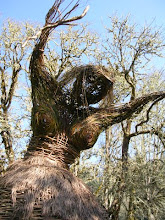In my previous blog I mentioned a brief history of
scrapbooks, and several books on the
subject. Writing With Scissors is probably the most scholarly of these, focusing as it does on some of the most historically significant albums and collections.
subject. Writing With Scissors is probably the most scholarly of these, focusing as it does on some of the most historically significant albums and collections.
Hooked on the subject by the discovery of a farm woman’s
scrapbook of clipped articles dedicated to the environment of the home that she
discovered in a used book store, Garvey went on to explore the world of
scrapbooks housed in libraries, archives, and historical societies. Scrapbooks
are often extremely personal, miniature archives of daily life not meant for
public consumption. “Every scrapbook is its own world,” she writes, “compelling
and impossibly frustrating.” She quotes from James Tate’s poem “Horseshoe” to
describe the experience of puzzling over these volumes,
I can’t
read the small print in the scrapbook:
does this
say, Relinquishing all bats, feeling
faint
on the balcony? There is so much
to be corrected here,
so many
scribbles and grumbles, blind premonitions.
Not only is some of the written material in a scrapbook
difficult to decipher, so too is the intent, substance, history, and sometimes
the identity of the record-keeper. These old albums do not much resemble the
attempted artistry of today’s modern memorabilia scrapbooks. They were often
kept in old ledgers, printed books of minimal interest (agricultural reports,
books of sermons, catalogs) or home-made constructions, or, as the early fad
progressed, in manufactured “scrap albums” with highly decorated covers, pages
designated for records of baby development, school progress, etc. (Often the
designations were ignored for more personal record-keeping.)
It is difficult to understand today just what the introduction
of inexpensive color reproduction meant to our Victorian ancestors. There was
an explosion of printing when color lithography produced prints, book
illustrations, trade cards, calling cards, postcards, greeting cards, and other
brightly-colored graphics. Until then, color work was done primarily by hand,
painted in watercolor by professional artisans and therefore expensive. Needless
to say, there was a frenzy of scrapbook-keeping of these items, sometimes
represented by real artistry in the arrangement of colorful ephemera.
There was a similar response when newspapers became
plentiful and inexpensive in the mid-19th century. Historically
important records were pasted into scrapbooks, material that might not
otherwise have survived the prejudices and politics of its day.
Scrapbooks kept during the Civil War represent both sides
of the political issues and battles. Those kept by Abolitionists describe many
of the conflicts and struggles on a personal level. Not only factual clippings,
but letters, photographs, poems, short stories, engravings, and other
memorabilia filled these volumes. Side by side, these records present a much
fuller picture of this painful era in American History.
Garvey examines the histories preserved in African
American Scrapbooks from the mid-1800s into the early 1900s. She notes that
these scrapbooks create an alternative to the historical records kept by white
society that might otherwise have been neglected and lost. These scrapbooks,
she says, witness the participation and contributions of African-Americans in
the development of the United States; present a record of race pride with
printed articles about struggles and achievements of black role models; compile the evidence of oppression and
mistreatment of African-Americans, often using the bigoted and biased white
press as a “hostile witness” against itself; and finally, the scrapbooks helped
define and support black communities by keeping their history, since they were
often blocked from access to libraries and newspaper files.
These were not piddly incidental volumes. A Philadelphia
janitor compiled over 100 huge pasted tomes starting in the 1850s. William H.
Dorsey made nearly 400 scrapbooks between the 1870s and 1903, and created a
museum in his home that also included books, prints, and other artwork that
depicted black history. And there were other significant collections.
Women’s activism in the early 20th century was
another area that received biased press coverage, if any. Women who spoke and
wrote publically about sensitive reforms such as Suffrage were often ridiculed,
described as unwomanly, and otherwise derided. They were forced to develop
public personalities that were more acceptably “feminine,” through means such
as knitting in public when attending lectures and events .
Garvey addresses each of these subjects in Writing With Scissors in depth, also
analyzing the importance of the records to future historians. Although
scholarly in format and subject, her enthusiasm creates a lively and enjoyable
text that is both informative and satisfying.





1 comment:
Just saw this smart and coherent article on scrapbook history, and writeup of Writing with Scissors. That's an astute connection between the sudden abundance of colorful lithographed printing and the popularity of scrapbooks in the 1880s and the abundance of cheap newspapers and newspaper scrapbooks. Looking forward to more posts!
Post a Comment